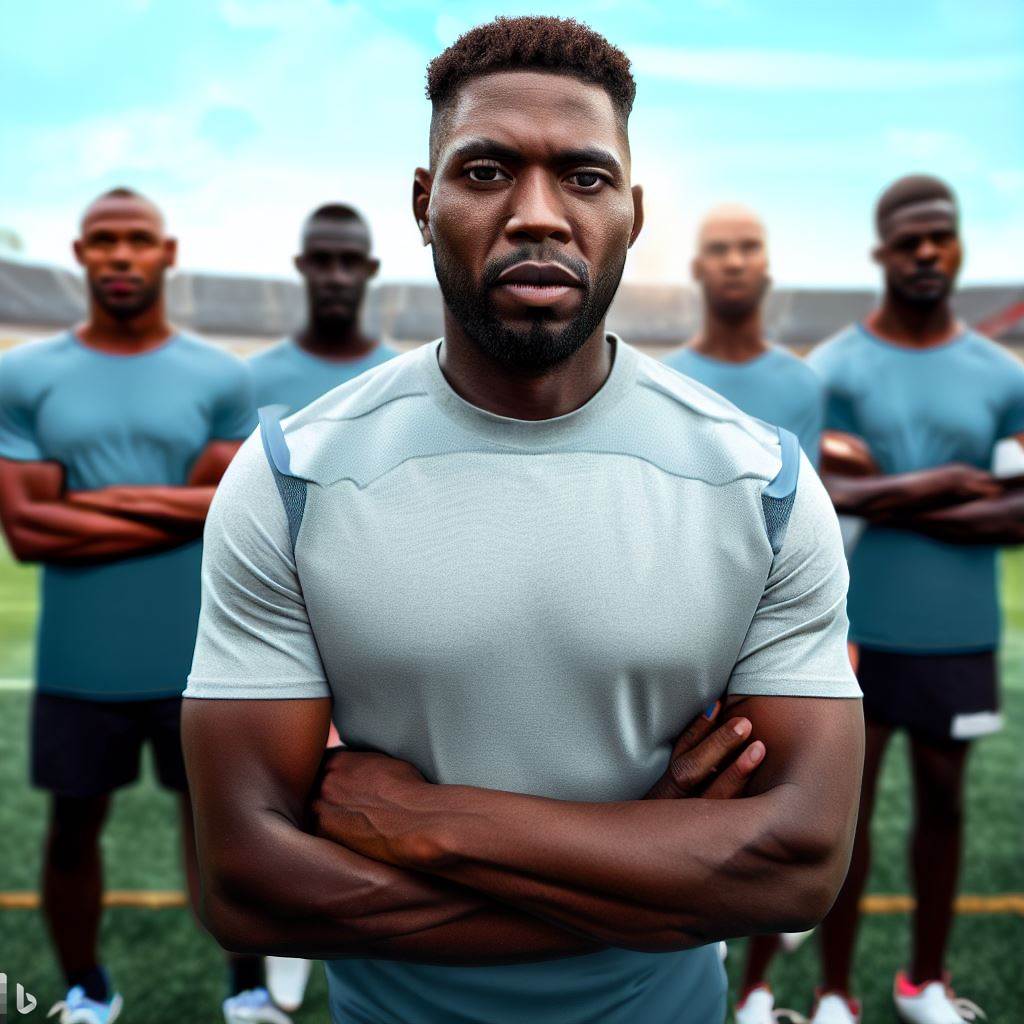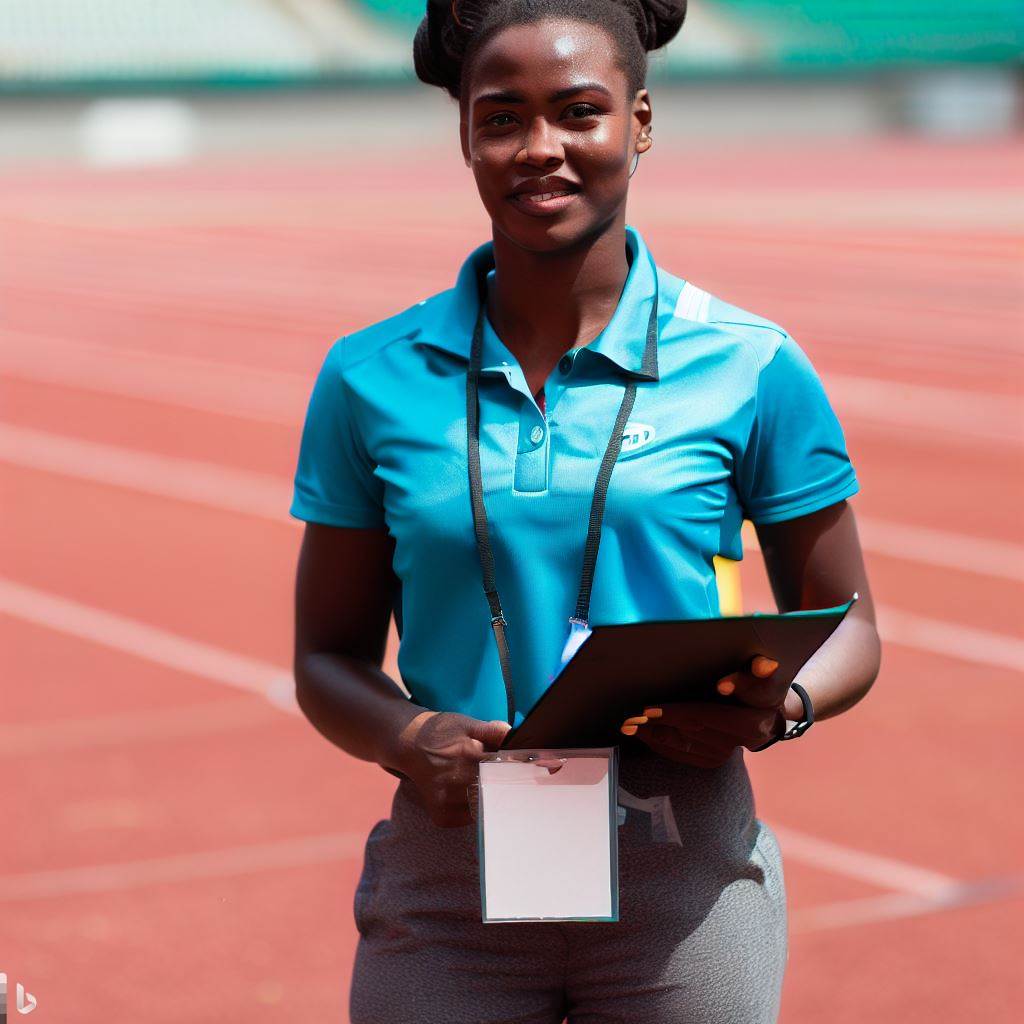Introduction
Explore the exciting prospects and innovations shaping the Assistant Athletic Training Future in Nigeria in this insightful blog post.
Assistant athletic trainers play a crucial role in supporting athletes with their physical injuries and rehabilitation.
This blog post explores the future of assistant athletic training in Nigeria, focusing on potential advancements and challenges.
Current State of Assistant Athletic Training in Nigeria
A. Overview of the current situation
- Assistant athletic training in Nigeria is still in its early stages of development.
- There is a lack of well-established programs and resources for assistant athletic trainers.
- The number of assistant athletic trainers in Nigeria is relatively low compared to other countries.
- The role of assistant athletic trainers is not fully recognized or utilized in the sports industry.
- The current situation calls for improvements in training and professional development opportunities.
B. Challenges and limitations faced by assistant athletic trainers
- Limited financial resources often hinder the establishment and growth of assistant athletic training programs.
- Inadequate infrastructure and equipment pose challenges for assistant athletic trainers in providing optimal care.
- There is a lack of awareness about the importance of assistant athletic trainers in managing injuries and promoting athlete performance.
- Limited access to advanced technologies and medical facilities limits the effectiveness of assistant athletic trainers.
- Assistant athletic trainers often face resistance and skepticism from coaches and athletes who underestimate their expertise.
C. The importance of addressing these issues for the future
- Prioritizing the development of assistant athletic training programs will enhance the overall sports ecosystem in Nigeria.
- Proper training and education for assistant athletic trainers will ensure quality healthcare for athletes.
- Investing in infrastructure and equipment will enable assistant athletic trainers to provide better care and prevent injuries.
- Creating awareness about the role and significance of assistant athletic trainers will enhance their recognition and utilization.
- Supporting and empowering assistant athletic trainers will contribute to the success of Nigerian athletes on the global stage.
In fact, the current state of assistant athletic training in Nigeria is marked by early development, challenges, and limitations.
The lack of resources, infrastructure, and recognition hampers the effectiveness of assistant athletic trainers.
However, addressing these issues and investing in their development will have far-reaching benefits for the future.
By prioritizing the growth of assistant athletic training programs, providing adequate resources, and creating awareness, Nigeria can enhance the quality of healthcare for athletes and improve their performance on the global stage.
Read: A Close Look at the Nigerian Professional Sports Infrastructure
Technological Advancements in Athletic Training
A. Transformation of Athletic Training through Technology
Technology has revolutionized the field of athletic training on a global scale.
With the advent of advanced tools and innovations, athletes can now receive better healthcare, improved performance analysis, and enhanced injury prevention.
One of the most significant ways technology has transformed athletic training is by providing accurate and real-time data.
Modern devices, such as wearable sensors and GPS tracking systems, allow athletic trainers to monitor athletes’ vital physiological parameters during training sessions and competitions.
The availability of this data enables trainers to assess the physical condition of athletes more precisely and tailor their training programs accordingly.
By analyzing the collected information, trainers can identify individual weaknesses and develop personalized strategies to improve performance.
Furthermore, technology has brought significant advancements in injury prevention.
Assistant athletic trainers can now utilize video analysis software to analyze athletes’ movements, detect biomechanical flaws, and suggest corrective measures.
This ensures that athletes can minimize the risks of injuries and perform at their best.
Another area where technology has impacted athletic training is rehabilitation.
Advanced tools like therapeutic ultrasound, electrical stimulation devices, and laser therapy equipment have contributed to faster and more effective recovery processes.
These technological advancements aid assistant athletic trainers in designing personalized treatment plans, optimizing their athletes’ recovery time.
B. Key Technological Advancements for Assistant Athletic Trainers
The evolution of technology has brought specific advancements that are particularly relevant to assistant athletic trainers.
These innovations streamline their work, enhance athlete monitoring, and improve overall efficiency.
One of the notable technological advancements is the emergence of telemedicine solutions.
Assistant athletic trainers can now remotely monitor athletes, provide consultations, and offer immediate feedback through video conferences.
This allows trainers to reach athletes in remote locations while minimizing travel time and costs.
The integration of artificial intelligence (AI) in athletic training has also proven to be beneficial.
AI-powered software can analyze vast amounts of performance data and provide valuable insights to assistant trainers.
This enables them to make data-driven decisions and create optimized training programs.
Moreover, the availability of virtual reality (VR) and augmented reality (AR) technologies has opened up new possibilities for assistant athletic trainers.
These technologies enable trainers to simulate sports scenarios, create immersive rehabilitation experiences, and reinforce athletes’ mental preparation for competitions.
C. Potential Impact of Technological Advancements in Nigeria
The potential impact of technological advancements in athletic training is significant for Nigeria’s assistant trainers and athletes.
Access to cutting-edge technology can bridge the gap between Nigeria and more developed nations in terms of athletic performance and sports medicine.
By embracing advanced technology, assistant athletic trainers in Nigeria can provide better and more comprehensive care to athletes.
This will enhance the overall health and well-being of the athletes, leading to improved performance on national and international stages.
Furthermore, the integration of technology can also attract more talented individuals to pursue careers in athletic training.
The potential for utilizing innovative tools and techniques can inspire and motivate aspiring trainers and contribute to the development of the field in Nigeria.
Summarily, technological advancements have transformed the field of athletic training globally.
The introduction of advanced tools has enhanced the monitoring of athletes, improved injury prevention, optimized rehabilitation, and facilitated remote consultations.
For assistant athletic trainers in Nigeria, embracing these advancements offers the potential to elevate the quality of care and performance for Nigerian athletes.
Read: Nigeria’s Athletics Professions: Potential and Pitfalls
Education and Training Opportunities for Assistant Athletic Trainers
A. Current Educational Requirements and Certifications for Assistant Athletic Trainers in Nigeria
Assistant athletic trainers in Nigeria are required to possess a bachelor’s degree in athletic training or a related field.
Additionally, they must obtain certification from the National Board of Athletic Training (NBAT) in Nigeria.
The educational requirements aim to ensure that assistant athletic trainers have a strong foundation in anatomy, physiology, biomechanics, first aid, emergency care, and injury prevention.
These core courses provide them with the necessary knowledge and skills to assist in the athletic training field.
The certification process involves passing the NBAT Examinations, which consist of both written and practical components.
The examinations test candidates on their theoretical knowledge as well as practical skills in providing sports injury management and rehabilitation.
By meeting these requirements, assistant athletic trainers in Nigeria can demonstrate their competence and commitment to providing quality care to athletes.
B. Availability and Quality of Training Programs for Aspiring Assistant Athletic Trainers
The availability of training programs for aspiring assistant athletic trainers in Nigeria is still limited.
There are a few universities and sports institutes that offer undergraduate programs in athletic training.
However, the quality of these training programs varies. Some institutions have well-equipped athletic training facilities and experienced faculty, while others may lack the necessary resources and expertise.
As a result, the training and education received by aspiring assistant athletic trainers may vary significantly depending on the institution they attend.
Furthermore, the number of training programs available is not sufficient to meet the growing demand for assistant athletic trainers in Nigeria.
As sports participation and awareness of athletic injuries increase, there is a need for more comprehensive and accessible training programs.
C. Potential Improvements and Initiatives for Enhancing Education and Training Opportunities
To enhance education and training opportunities for assistant athletic trainers in Nigeria, several initiatives can be implemented:
- Expansion of academic programs: Collaborations between universities and sports institutions can lead to the creation of more academic programs in athletic training.
- Standardization of curriculum: Establishing a standardized curriculum across all training programs can ensure that aspiring assistant athletic trainers receive consistent education.
- Faculty development: Invest in professional development opportunities for faculty members to enhance their expertise and teaching abilities.
- Increased funding: Allocate more resources to training programs to improve facilities, equipment, and practical training opportunities.
- Continuing education: Implement mandatory continuing education requirements to encourage assistant athletic trainers to stay updated on current practices and advancements in the field.
- Industry partnerships: Foster collaborations between sports organizations, professional athletic trainers, and training programs to provide internships, mentorship, and job placement opportunities for aspiring assistant athletic trainers.
By implementing these improvements and initiatives, Nigeria can enhance the education and training opportunities for assistant athletic trainers, ensuring a skilled workforce that can contribute to the future of sports medicine in the country.
Read: Breaking Down Nigeria’s Athletics Training Systems
Collaboration and Networking in Assistant Athletic Training
A. Importance of Collaboration and Networking in the Field
Collaboration and networking play a crucial role in the growth and development of assistant athletic training in Nigeria.
By working together and establishing connections within the field, assistant athletic trainers can enhance their knowledge, skills, and overall effectiveness.
Collaboration allows assistant athletic trainers to share their experiences, expertise, and best practices.
By collaborating, they can learn from each other’s successes and challenges, thereby improving their own practices.
They can exchange ideas, techniques, and strategies to provide better care for athletes.
Networking is equally important as it enables assistant athletic trainers to expand their professional connections.
By connecting with other professionals in the field, they can access a wealth of resources, such as research articles, professional development opportunities, and mentorship programs.
These connections also enable them to stay updated with the latest advancements and trends in athletic training.
Moreover, collaboration and networking promote a sense of community and unity within the profession.
By building relationships with fellow assistant athletic trainers, they can create a support system that fosters professional growth and emotional well-being.
This camaraderie contributes to a positive work environment and promotes job satisfaction and retention.
B. Current State of Collaboration and Networking Opportunities for Assistant Athletic Trainers in Nigeria
Currently, the collaboration and networking opportunities for assistant athletic trainers in Nigeria are limited.
Due to the lack of a structured system, assistant athletic trainers often work in isolation, with minimal opportunities to interact with their peers.
Professional organizations and associations dedicated to athletic training are scarce in Nigeria.
This dearth of organizations makes it challenging for assistant athletic trainers to connect with others in the field.
The absence of a network means they miss out on valuable opportunities for collaboration and professional growth.
Furthermore, the geographical spread of assistant athletic trainers across Nigeria poses a logistical challenge for collaboration.
The distances between training facilities and the limited means of communication hinder the establishment of regular meetings or conferences.
As a result, assistant athletic trainers face difficulty in sharing knowledge and learning from each other.
Read: Assistant Athletic Trainer: Path to Success in Nigeria

Strategies to Promote and Improve Collaboration and Networking within the Profession
To promote collaboration and networking within the assistant athletic training profession in Nigeria, several strategies can be implemented:
- Establish Professional Organizations: Creating dedicated organizations that focus on athletic training can provide a platform for assistant athletic trainers to connect, share ideas, and collaborate on projects.
These organizations can also organize conferences and seminars for professional development. - Foster Mentorship Programs: Instituting mentorship programs that pair experienced athletic trainers with aspiring assistant athletic trainers can help facilitate networking and knowledge exchange.
Mentors can provide guidance, support, and valuable insights to their mentees. - Utilize Online Platforms: The use of online platforms, such as social media groups and forums, can overcome geographical barriers and allow assistant athletic trainers from different locations to connect and interact regularly.
Sharing resources, asking questions, and engaging in discussions becomes much easier through these platforms. - Encourage Research Collaborations: Encouraging collaborative research projects among assistant athletic trainers can foster collaboration and networking.
These research projects can address specific challenges faced in Nigeria and provide evidence-based solutions for the profession. - Organize Regional Workshops: Conducting regional workshops or training sessions throughout Nigeria can bring assistant athletic trainers together and provide opportunities for networking and knowledge sharing.
These workshops can focus on different aspects of athletic training, catering to the specific needs of different regions.
Overall, collaboration and networking are vital for the advancement and success of assistant athletic training in Nigeria.
By embracing these practices, assistant athletic trainers can improve their skills, share knowledge, and foster a supportive professional community.
Implementing strategies to promote collaboration and networking will contribute to the growth and development of the profession, ultimately benefiting athletes and the field of athletic training as a whole.
The Role of Assistant Athletic Trainers in Sports Injury Prevention and Rehabilitation
A. Current role of assistant athletic trainers in Nigeria in preventing and rehabilitating sports injuries
Assistant athletic trainers play a crucial role in Nigeria in preventing and rehabilitating sports injuries.
They work closely with athletes and provide immediate medical attention and first aid during sporting events.
Assistant athletic trainers also educate athletes on injury prevention techniques and proper training methods.
They are responsible for assessing injuries, creating treatment plans, and overseeing the rehabilitation process.
These trainers collaborate with other healthcare professionals to ensure effective injury management and recovery.
Assistant athletic trainers in Nigeria are often the first-line responders to sports-related injuries and emergencies.
They play a vital role in minimizing the severity of injuries and optimizing athletes’ recovery outcomes.
B. Challenges and opportunities in this aspect of assistant athletic training
Assistant athletic trainers in Nigeria face several challenges in their role in sports injury prevention and rehabilitation.
Limited resources and funding hinder their ability to provide comprehensive care and advanced treatment options.
The lack of awareness about the importance of athletic training also poses challenges in their professional advancement.
Opposing cultural beliefs and practices may discourage athletes from seeking proper medical attention and following rehabilitation protocols.
Additionally, the absence of standardized protocols for sports injury prevention and rehabilitation poses difficulties in consistent practice.
Despite these challenges, there are opportunities for assistant athletic trainers to enhance their role.
Increasing awareness about the benefits of athletic training can help overcome cultural barriers and encourage athletes to prioritize their health.
Collaboration with government bodies, sports organizations, and professional associations can improve resources and funding.
Continued education and training programs can enhance the skills and knowledge of assistant athletic trainers.
Advocacy for the development of national guidelines for sports injury prevention and rehabilitation can ensure consistent and evidence-based practice.
Opportunities also exist for research and innovation in the field, leading to advancements in sports medicine practices.
C. Recommendations to enhance the role of assistant athletic trainers in sports injury prevention and rehabilitation
To enhance the role of assistant athletic trainers in sports injury prevention and rehabilitation in Nigeria, several recommendations can be considered:
- Increase funding and resources dedicated to athletic training programs in schools, sports clubs, and healthcare facilities.
- Develop and implement standardized protocols for sports injury prevention, assessment, treatment, and rehabilitation.
- Conduct educational campaigns and workshops to raise awareness about the importance of athletic training and proper injury management.
- Foster collaboration among assistant athletic trainers, healthcare professionals, and sports organizations to provide comprehensive care.
- Establish a certification board or governing body to regulate and ensure the quality of athletic training practice in Nigeria.
- Create opportunities for professional development, continuing education, and research to enhance the skills and knowledge of assistant athletic trainers.
- Encourage athletes, coaches, and parents to prioritize athlete safety and adhere to injury prevention and rehabilitation protocols.
- Collaborate with international sports medicine organizations and experts to leverage their expertise and best practices.
By implementing these recommendations, Nigeria can enhance the role of assistant athletic trainers in sports injury prevention and rehabilitation.
This will lead to improved healthcare services for athletes, reduced injury rates, and enhanced performance outcomes.
Future Prospects and Opportunities for Assistant Athletic Trainers in Nigeria
A. Potential growth and expansion of the field in Nigeria
- The field of athletic training in Nigeria has immense potential for growth and expansion.
- As awareness about sports and fitness increases, the demand for assistant athletic trainers will also rise.
- The Nigerian government has expressed a commitment to sports development, further emphasizing the potential growth in this field.
- Investment in sports facilities, training centers, and coaching infrastructure will contribute to the expansion of athletic training in Nigeria.
B. Emerging employment opportunities for assistant athletic trainers
- Assistant athletic trainers can find employment opportunities in professional sports teams, both locally and internationally.
- Educational institutions, including universities and colleges, require assistant athletic trainers to support their sports programs.
- Sports rehabilitation centers and private fitness clubs also offer employment prospects for assistant athletic trainers.
- The increasing interest in individual sports and the rise of recreational sports centers open up new opportunities for these professionals.
C. Significance of professional development and specialization in the future
- Continuous professional development is crucial for assistant athletic trainers to stay relevant in their field.
- Specialization in areas such as sports medicine, strength and conditioning, and rehabilitation can enhance career prospects.
- Certifications and advanced degrees in athletic training and related fields provide a competitive edge.
- With advancements in sports science and technology, staying updated through professional development is vital for success.
Essentially, the future prospects and opportunities for assistant athletic trainers in Nigeria are promising.
The potential growth and expansion of the field, driven by government support and increased awareness of sports, create a favorable environment for professionals in this domain.
Emerging employment opportunities in sports teams, educational institutions, and specialized centers further boost the prospects.
However, it is essential for assistant athletic trainers to prioritize professional development and specialization to stay competitive and take advantage of the evolving landscape.
By continuously upgrading their skills and knowledge, these professionals will enhance their career prospects and contribute to the development of sports and fitness in Nigeria.
See Related Content: Future Prospects for Nigeria’s Athletics Industry
Conclusion
In this blog post, we discussed the future of assistant athletic training in Nigeria.
It is of utmost importance to invest in the future of assistant athletic training in Nigeria.
As we look ahead, let us remember that the development of this field is crucial for the success of Nigerian athletes.
It is essential to provide adequate support, resources, and training opportunities to assistant athletic trainers.
By doing so, we can ensure the well-being and performance of athletes and contribute to the growth of sports in Nigeria.
Let us join hands and take action to create a brighter future for assistant athletic training in Nigeria!




